This post may contain affiliate links. Please read our disclosure policy.
A twist of the traditional marinara sauce, this easy Red Wine Pasta Sauce recipe is a deeply flavored red sauce perfect for any pasta dish!

I love my go-to tomato pasta sauce recipe, but sometimes I want something a little different. Rich red wine adds an extra depth of flavor and a complexity to this sauce that I LOVE! This is a nice, thick, rich sauce that is bursting with fresh Italian herb flavors!
Use it in a robust, lasagna recipe or in a lighter, waist-friendly whole wheat vegetable lasagna. Pour a healthy scoop over pasta with ricotta meatballs, use it in an easy, baked penne pasta or stuffed shells with meat, or eat it with a spoon straight from the pot (what?! You don’t do that too?). Whatever you do with it, I know it will be fabulous!
Table of Contents
Why you will love Red Wine Spaghetti Sauce:
- The depth of flavor can’t be matched! Red wine adds boldness and richness to tomato sauce. It also adds a touch of bright acidity that makes the whole sauce taste lively and vibrant.
- It’s an easy sauce recipe. Despite this being a long-cooked sauce, it’s actually incredibly easy to make! All you need to do is chop and sweat some aromatics, cook down the wine, add the remaining ingredients, and stir occasionally until the sauce is ready.
- You can make a double batch! If you’re having a large party or want to meal-plan, you can easily double this recipe by selecting the 2x button in the recipe card below.
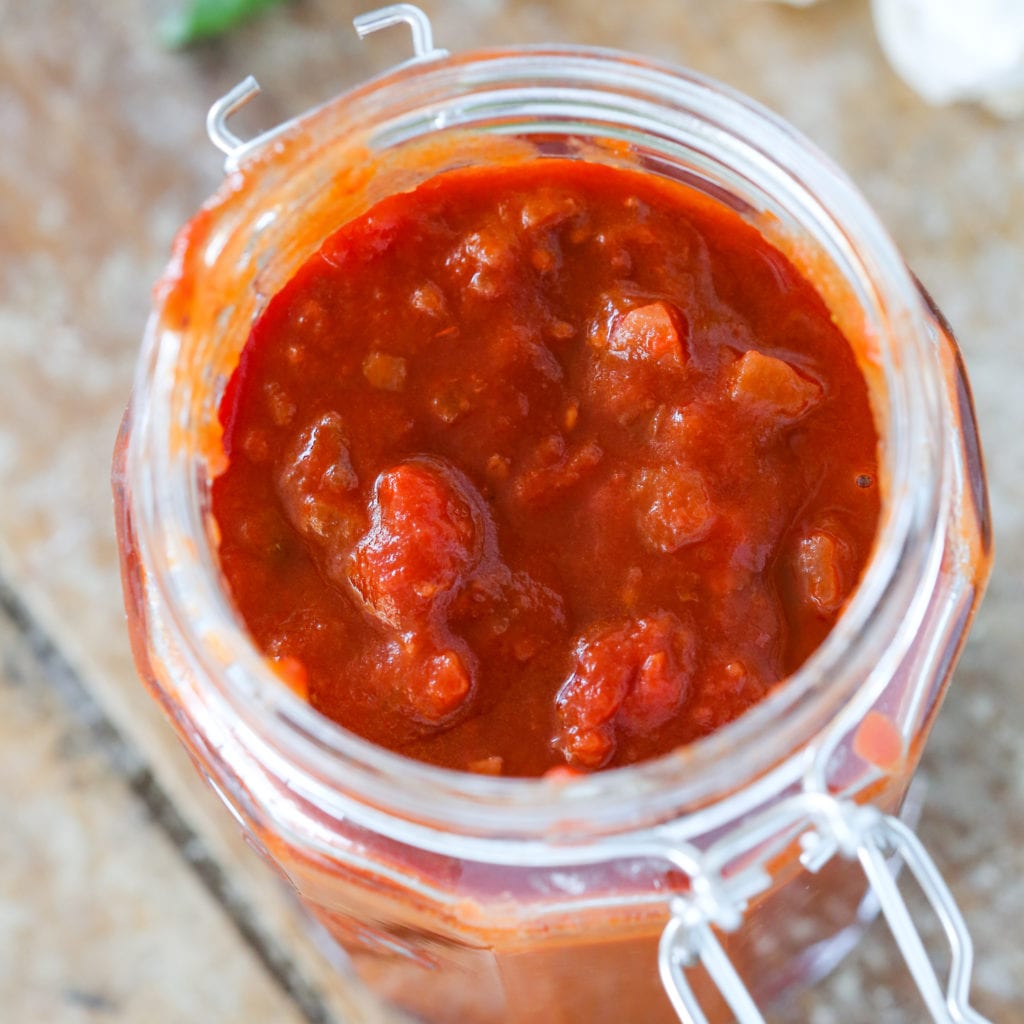
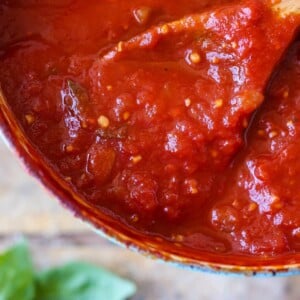
Professional Tips for making this red wine pasta sauce:
- Sweat your onions and garlic, don’t brown them. Be patient and allow them to cook slowly on no higher than medium heat!
- For a thicker sauce, allow it to reduce for the last hour with the lid off of the pot. If you find the sauce to be too thick, add a bit of chicken stock at a time and stir until you reach your desired consistency.
- If your sauce tastes too acidic, add 1 tablespoon of granulated sugar to counterbalance that acid. You can also add a tablespoon or more of tomato paste, which will lend a natural sweetness.
Ingredients
- Onions: You will want to purchase about 3 onions in order to produce 3 cups of finely diced onion. I recommend using a yellow onion or sweet onion for this sauce.
- Garlic: I recommend using fresh garlic for this recipe. It will not have the same flavor if you substitute this for garlic powder. You can use jarred, minced garlic for an easy shortcut.
- Extra Virgin Olive Oil: While a good quality extra virgin olive oil is always a nice addition, the bold flavors of this sauce don’t require you to use your highest quality oil here.
- Dry Red Wine: I used Chateau Ste. Michelle Cabernet Sauvignon but any pinot noir, cabernet or chianti will be delightful. I would not recommend using Burgundy or merlot because the flavor might be overpowering and the tannins might add a more bitter flavor. Buy two bottles, and make a batch of my red chili recipe with ground beef!
- Canned Tomatoes: I like to use the traditional whole San Marzano tomatoes for this recipe but whole, peeled roma tomatoes can also be used. San Marzano tomatoes can be a bit pricier. Honestly Amazon’s Happy Belly brand of whole tomatoes is an excellent lower cost option.
- Tomato Paste: Tomato paste adds an extra layer of flavor to and helps with thickening the sauce.
- Chicken Stock Try this great recipe for chicken stock. You can also use store bought chicken stock if you are short on time. I prefer to purchase a low sodium stock and season to my taste.
- Fresh Basil: Using fresh basil is key here. It’s much more flavorful than dried basil, with an earthy, fragrant, somewhat sweet taste. For a little extra visual interest (and flavor), top a dish of fresh pasta and red wine pasta sauce with a sprinkling of fresh herbs like parsley or basil.
- Fresh Thyme: I love to use fresh thyme in this recipe for its earthy, lemony, and slightly floral taste.
- Salt: Kosher salt is what I recommend for cooking. It is less salty by volume than other varieties of salt, making it easier to taste as you go.
- Black Pepper Freshly ground pepper has the best flavor, and there’s something rewarding about using a peppermill and adjusting the grind size.
- Dried Oregano: Oregano is a classic flavor in Italian cooking. Just a pinch of dried oregano adds a peppery, herbaceous taste to the sauce.
- Dried Sage: Sage is an often overlooked herb that’s perfect for this flavor-packed sauce. Dried sage has a bit of a piney, citrusy flavor and aroma.
Variations
- Add red pepper flakes for a hint of heat in your sauce! I like to add red pepper flakes while sweating the onion and garlic to allow them to release their flavor.
- For a completely smooth sauce, use an immersion blender after the sauce has finished cooking to remove any chunks.
- If you don’t have all of the herbs called for in this recipe, try using an Italian herb blend. An Italian herb blend typically contains most of the flavors in this sauce.
How to Make red wine pasta sauce with basil
Use these instructions to make the perfect red sauce every time. Further details and measurements can be found in the recipe card below!
Step 1: Heat a 5 ½- to 7-quart Dutch oven or heavy-bottomed stock pot over medium heat until hot. Add olive oil, swirling to coat. Add the garlic and onions and saute until the onions are translucent. Keep the heat on medium and adjust as you cook because you don’t want to brown them.
Step 2: Add the red wine and cook for about 2 minutes, stirring with a flat wooden spatula until the wine has reduced slightly.
Step 3: In a separate bowl, squeeze the whole tomatoes to break them up. I do this in the sauce pot to save cleaning a bowl. If you choose to do the same, do it before adding the chicken stock so you don’t have to worry about splashing! Add all of your remaining ingredients, bring to a slow boil then reduce heat to low and simmer sauce, covered, for 4 to 8 hours; stirring occasionally.
You can add more chicken stock if the sauce gets too thick. I like a thicker sauce, so I allow mine to reduce for the last half hour with the top off.
Step 4: After about 2 hours, I like to taste the sauce to make sure it doesn’t need any additional seasoning. Add kosher salt to taste.
Step 5: Towards the end of your cook time, taste the sauce again to see if it is too acidic. If it is and that isn’t your thing, you can add 1 tablespoon of granulated sugar to counterbalance that acid. I find it really varies by batch and the quality of the tomatoes
Step 6: Serve over your favorite pasta, or cool and store it for later use.

Chef Lindsey’s Recipe Tip
Did you know that you can freeze homemade pasta sauce? In order to do so, allow the pasta sauce to cool completely, then transfer it in batches to resealable plastic or silicone freezer bags. You can then freeze these bags flat on top of a sheet pan to save space in your freezer.
Frequently Asked Questions
Store leftover tomato sauce in an airtight container in the fridge for 3 to 5 days. You can also freeze this sauce for around 3 to 4 months in freezer-safe plastic or silicone bags. The sauce will remain safe to eat after this time, but the flavor will begin to fade.
To make pasta sauce thicker, continue cooking the sauce uncovered to allow the liquid to reduce. You can also add a scoop of pasta water when serving to thicken the sauce and allow it to bind better to the pasta.
Red wine adds a robust, rich flavor to tomato sauce. It also adds a bit of acidity which results in a bright, vibrant taste.
When selecting a wine for this recipe, use one that you enjoy drinking. Choose your favorite dry red wine, such as Cabernet Sauvignon, Pinot Noir, or Chianti. I would not recommend using Burgundy or merlot because the flavor might be overpowering and the tannins might add a more bitter flavor.
If you tried this recipe and loved it please leave a 🌟 star rating and let me know how it goes in the comments below. I love hearing from you; your comments make my day!
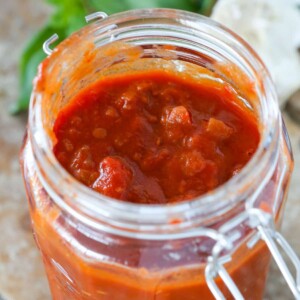
Red Wine Pasta Sauce
Ingredients
- 3 cups onion finely diced
- 4 tablespoons garlic minced
- 3 tablespoons olive oil
- ½ cup dry red wine I used a reasonably priced Cabernet Sauvignon
- 2 28-oz cans San Marzano tomatoes
- 2 6-oz cans tomato paste
- 2 cups chicken stock
- ⅓ cup fresh basil minced
- 3 teaspoons fresh thyme
- 3 large pinches Kosher salt
- 1 teaspoon freshly ground black pepper
- 2 teaspoons dried oregano
- 1 teaspoon dried sage
Instructions
- Heat a 5 ½- to 7-quart Dutch oven or heavy-bottomed stock pot over medium heat until hot. Add olive oil, swirling to coat. Add the garlic and onions and sauté until the onions are translucent. Keep the heat on medium and adjust as you cook because you don't want to brown them.
- Add the red wine and cook for about 2 minutes, stirring with a flat wooden spatula until the wine has reduced slightly.
- In a separate bowl, squeeze the whole tomatoes to break them up. I do this in the sauce pot to save cleaning a bowl. If you choose to do the same, do it before adding the chicken stock so you don’t have to worry about splashing! Add all of your remaining ingredients, bring to a slow boil then reduce heat to low and simmer sauce, covered, for 4 to 8 hours; stirring occasionally.
- You can add more chicken stock if the sauce gets too thick. I like a thicker sauce, so I allow mine to reduce for the last half hour with the top off.
- After about 2 hours, I like to taste the sauce to make sure it doesn’t need any additional seasoning. Add kosher salt to taste.
- Towards the end of your cook time, taste the sauce again to see if it is too acidic. If it is and that isn’t your thing, you can add 1 tablespoon of granulated sugar to counterbalance that acid. I find it really varies by batch and the quality of the tomatoes
- Serve over your favorite pasta, or cool and store it for later use.
Video
Notes
Nutrition
Before You Go
I hope you enjoyed this professional chef-tested recipe. Check out our other delicious, chef-developed sauce recipes! Or head directly to our favorite Chicken in White Wine Sauce!
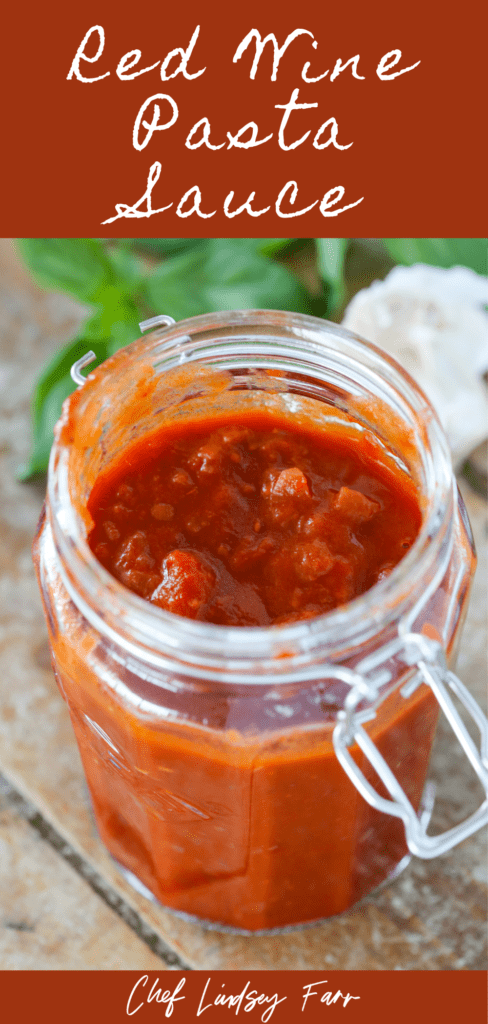
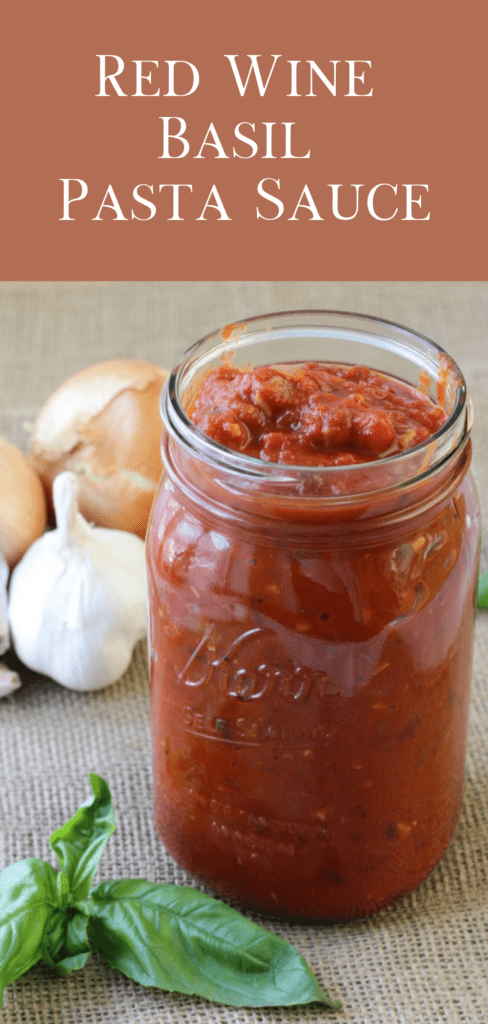

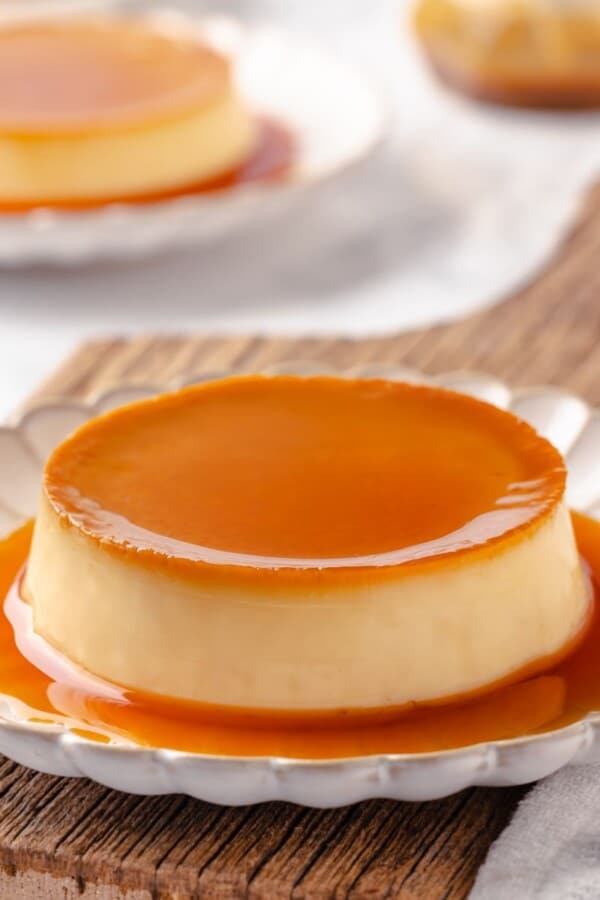

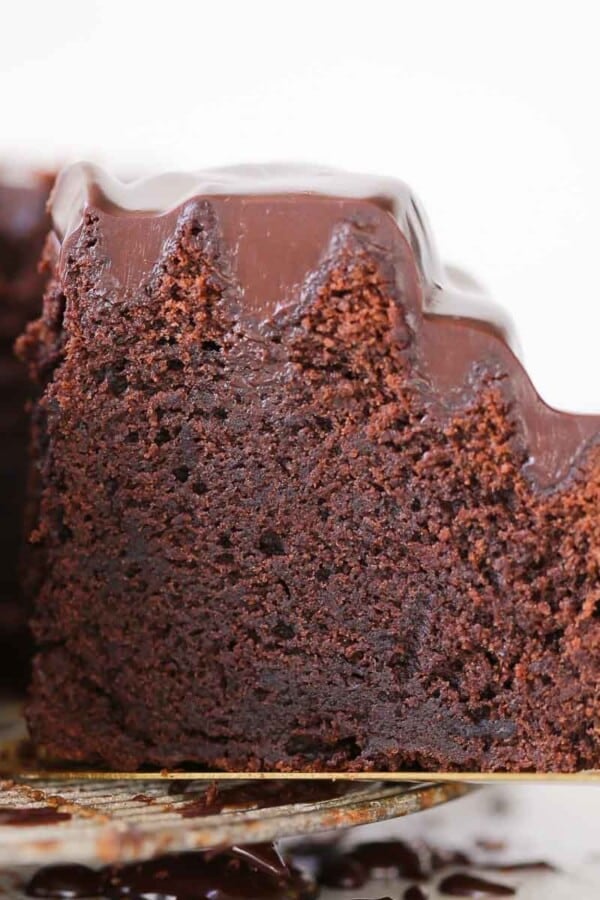








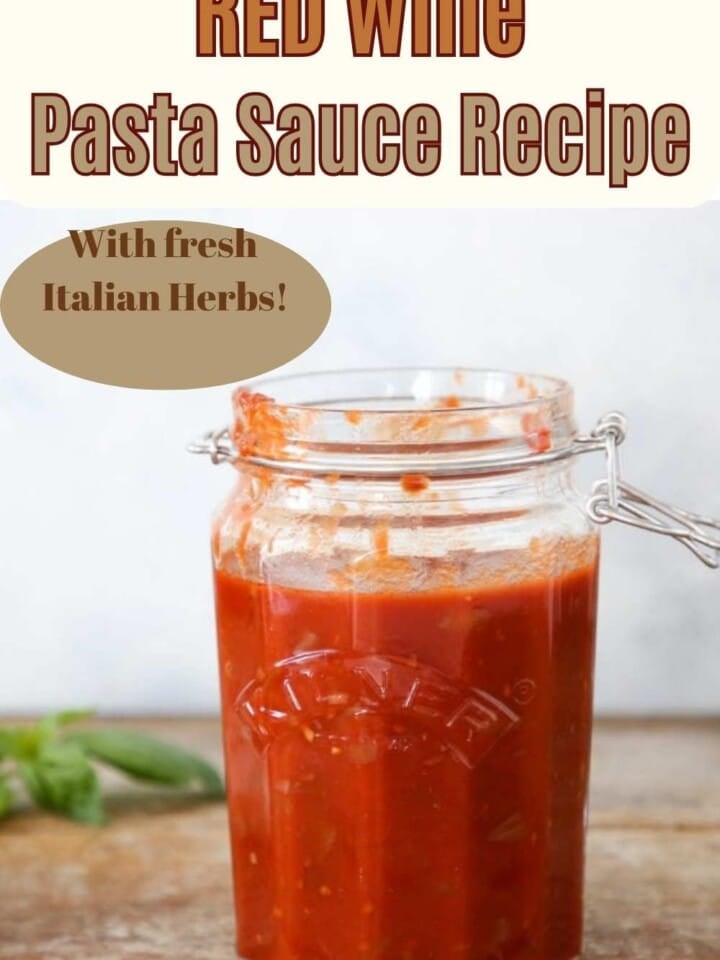
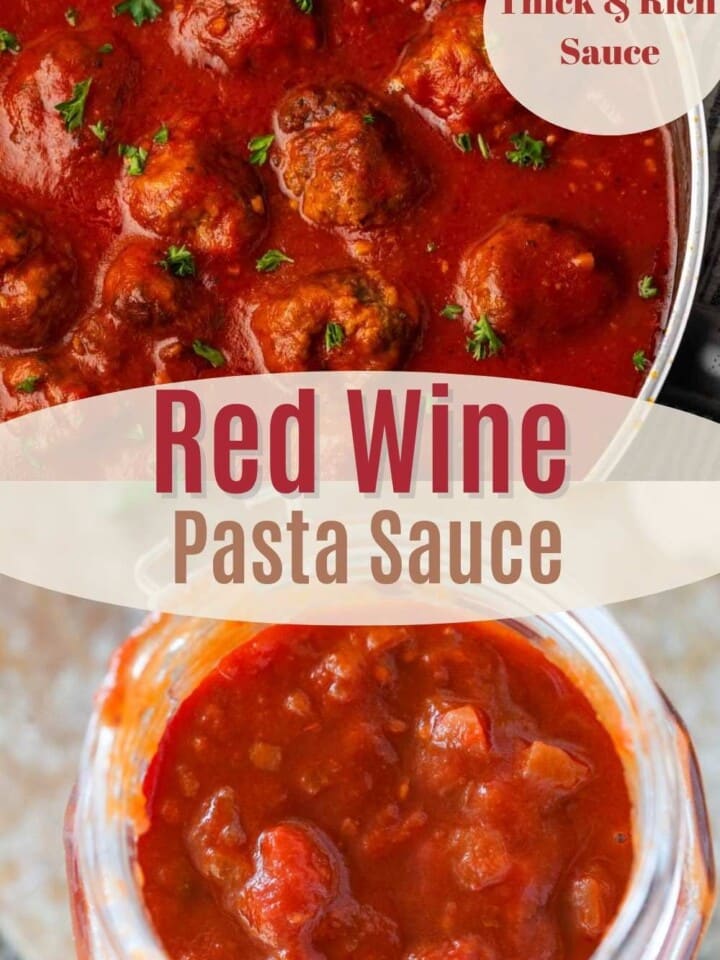
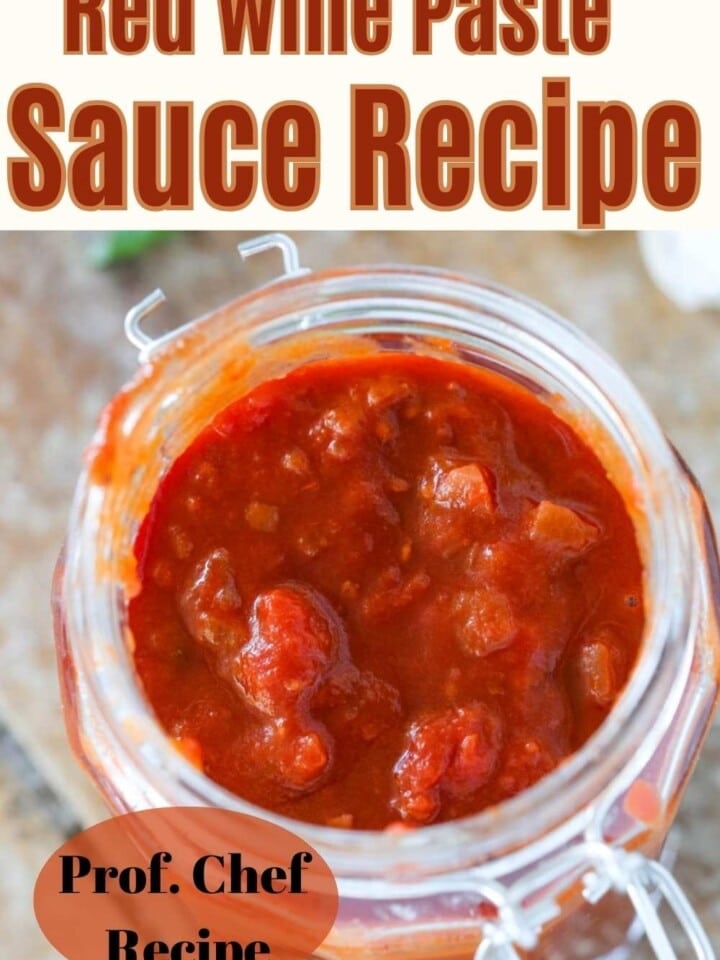
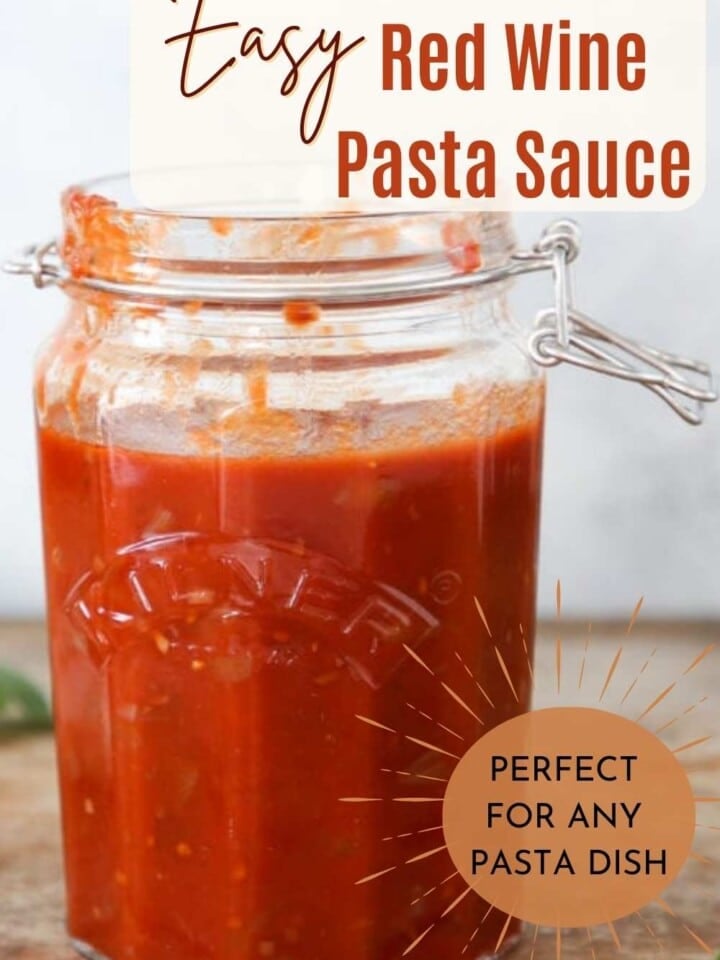
Great recipe! Thank you! One thing that puzzles me is that in recipe after recipe cooks say to bring the wine up to a high heat to burn off the alcohol. I don’t agree. You “injure” the wine. The alcohol is minimal. Especially if the sauce is going to be cooked for a while. Not only does the wine emit a great aroma in your kitchen when cooking but adds great flavor to the sauce. Frankly wine can probably be added to any food to be cooked. Thanks. Kenneth.
Hi Kenneth, I think it depends on who will be eating it. If I am making this for my family (including a 1 yr old), I prefer to cook out the alcohol. I also like reducing the wine to concentrate the flavors, but the beauty of cooking, is that you can tailor it to your tastes! ~Lindsey
This is a really cool page. One of the best posts I’ve found in quite a while. I hope to see more.
Thank you!